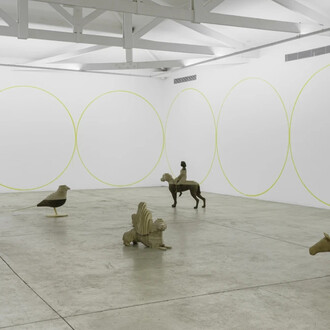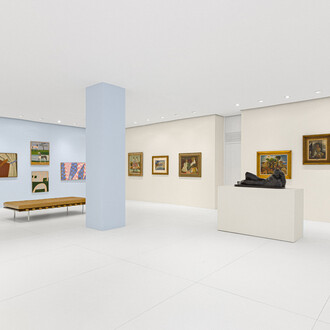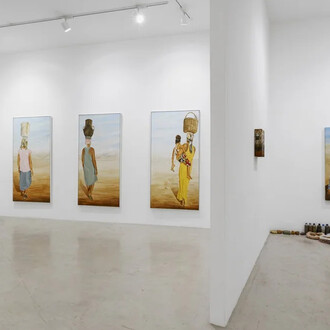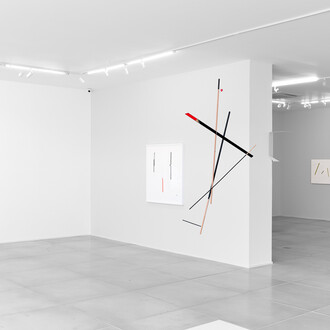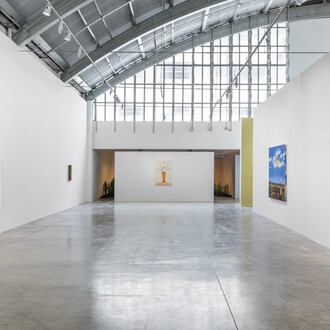Since the 2000s, Carla Zaccagnini has been studying and collecting symbolic representations of nations, from their hymns to their flags. In her sixth solo show at Vermelho, Zaccagnini brings together, for the first time, three works articulated around these collections. She also presents a video finalized in 2017.
In Prisma [Prism], initiated in 2010 and finished in 2018, Zaccagnini creates a version of the game Pega Varetas [Mikado], where gigantic rods carry the chromatic distribution of the flags from all the world’s nations. The artist discovered that all the national flags, together, are formed by 88 tones. From this study, Carla divided the tones by percentages in relation to the total sum and distributed them proportionally by the rods of their game; as if, in a single gesture (that of releasing the rods in the beginning of the game), the tones, as well as the nations, could be mixed.
In World Score, of 2018, Zaccagnini created a hymn common to all nationalities from the coincident notes in the sum of the national hymns. Overlapping the various hymns, the artist highlighted the notes that coincided with being written in equal distance from the beginning of the songs, by two or more composers. Zaccagnini emphasizes her intention in the text she wrote to accompany the exhibition: "How would this new music sound when being made from what is common to all the nations; however, taken from what differentiate each one of them?"
Sobre um mesmo campo [On the same field] (2011) is part of a comparative study of national flags by the artist, a project still under development. In this part of the project, figurative elements represented in flags from all countries of the world were grouped into 13 categories: Moons, Suns, Stars, Constellations, Maps, Vessels, Constructions, Trees, Birds, Mammals and Dragons, Weapons, Shields and Crowns.
Cut out from a field of black paper, these figurative elements are presented here as absence, a void in the hypothetical common space from which they might have been withdrawn before being placed in the different flags from the different countries which, one by one, they represent.
Ao sol do novo mundo [In the sun of the new world] (2016-2017) was filmed in a mansion of the architectonic group of buildings known as Vila Itororó, built during the XX century for residential and leisure purposes. In 2006, Vila Itororó was declared a public utility area, having been expropriated by the State of São Paulo for cultural purposes. In a room of a villa in the village, the artist found several stained glass windows with different flags, including the Brazilian. Throughout the day, the light that enters through this specific stained glass makes the Brazilian flag "slide" over the floor. This path traveled by the projection of the flag was recorded by Zaccagnini during two and a half hours. In the background, the sound of reforms taking place in the complex opposing a constructive potential to the ruin suggested by the course of the flag that disintegrates on the floor.
In 2018, Zaccagnini had a solo show at Museo Experimental El Eco, Mexico City, and also participated in group shows in Sweden, Brasil and Mexico.
Carla Zaccagnini has in her CV participations in major exhibits including 8ª Bienal de Berlim, 9ª Bienal de Shangai and 28ª Bienal de São Paulo. The artist also had her work shown in a wide range of museums including Museu de Arte de São Paulo (MASP - Brasil), Van Abbemuseum (The Netherlands), Malmö Kunstmuseum (Sweden), Museo de Arte Contemporáneo de Castilla y León (MUSAC – Spain), Nationalmuseum (Sweden).
Seu trabalho está presente em importantes coleções como Pinacoteca do Estado de São Paulo (Brasil), Tate Modern (Ingleterra), Kadist Art Foundation (EUA), Cisneros Fontanals Art Foundation (EUA), Solomon R. Guggenheim (EUA) e Museu de Arte de São Paulo – MASP (Brasil).









